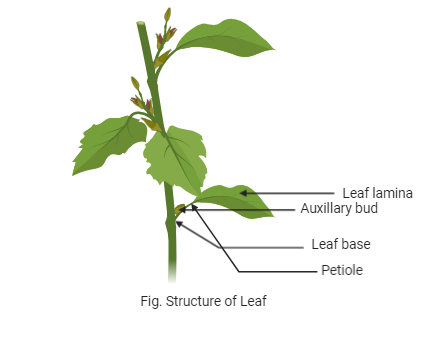
A leaf is identified from
A. Flat green lamina
B. Presence of leaf blade and petiole
C. Presence of axillary bud
D. Occurrence of chlorophyll
Answer
544.2k+ views
Hint: Leaves belong to the shoot system in plants and are part of vegetative reproduction. Plants make their own food through photosynthesis with the help of sunlight. The leaves of plants can absorb a large amount of light with the help of chlorophyll pigment which is also responsible for the green colour of leaves.
Complete answer: The morphology of a plant consists of a root system that is the underground part and a shoot system that is a part of the plant that is above the axis or above the ground. The root system comprises primary roots and secondary roots, while the shoot system in plants comprises flowers, fruits, stem, leaves, nodes (part from which leaves arise) and internodes (the part between the nodes). The root, stem and leaves constitute the vegetative parts of the body, whereas fruits, flowers, and seeds constitute the reproductive system of the body. These plants undergo few modifications so that the plant can survive in adverse conditions like floods, drought, etc.

Leaves are an important part of the plant that perform photosynthesis and produce food for the plant. The three parts of the leaves are leaf base, petiole and lamina. The part that attaches the leaf to the stem is the leaf base. Leaf lamina is a green-coloured expanded portion of the leaf. The petiole is a portion connecting the leaf lamina to the leaf base. Leaves also have an axillary bud which is present between the leaf and stem at the upper angle of the axis which can be defined as a characteristic feature of the leaf as other parts like lamina, petiole, chlorophyll can be seen in the root, stem, and also on branches as modifications.
Hence, the correct answer is option C.
Note: Modifications in the stem can form lamina on the stem which is not a leaf. Similarly, stem modifications can form a petiole, chlorophyll can be present on branches of leaves. Hence, axillary buds are the characteristic feature to identify leaves as it is found only on leaves in the whole shoot system.
Complete answer: The morphology of a plant consists of a root system that is the underground part and a shoot system that is a part of the plant that is above the axis or above the ground. The root system comprises primary roots and secondary roots, while the shoot system in plants comprises flowers, fruits, stem, leaves, nodes (part from which leaves arise) and internodes (the part between the nodes). The root, stem and leaves constitute the vegetative parts of the body, whereas fruits, flowers, and seeds constitute the reproductive system of the body. These plants undergo few modifications so that the plant can survive in adverse conditions like floods, drought, etc.

Leaves are an important part of the plant that perform photosynthesis and produce food for the plant. The three parts of the leaves are leaf base, petiole and lamina. The part that attaches the leaf to the stem is the leaf base. Leaf lamina is a green-coloured expanded portion of the leaf. The petiole is a portion connecting the leaf lamina to the leaf base. Leaves also have an axillary bud which is present between the leaf and stem at the upper angle of the axis which can be defined as a characteristic feature of the leaf as other parts like lamina, petiole, chlorophyll can be seen in the root, stem, and also on branches as modifications.
Hence, the correct answer is option C.
Note: Modifications in the stem can form lamina on the stem which is not a leaf. Similarly, stem modifications can form a petiole, chlorophyll can be present on branches of leaves. Hence, axillary buds are the characteristic feature to identify leaves as it is found only on leaves in the whole shoot system.
Recently Updated Pages
Master Class 12 Business Studies: Engaging Questions & Answers for Success

Master Class 12 Economics: Engaging Questions & Answers for Success

Master Class 12 English: Engaging Questions & Answers for Success

Master Class 12 Maths: Engaging Questions & Answers for Success

Master Class 12 Social Science: Engaging Questions & Answers for Success

Master Class 12 Chemistry: Engaging Questions & Answers for Success

Trending doubts
What is meant by exothermic and endothermic reactions class 11 chemistry CBSE

Which animal has three hearts class 11 biology CBSE

10 examples of friction in our daily life

One Metric ton is equal to kg A 10000 B 1000 C 100 class 11 physics CBSE

1 Quintal is equal to a 110 kg b 10 kg c 100kg d 1000 class 11 physics CBSE

Difference Between Prokaryotic Cells and Eukaryotic Cells




